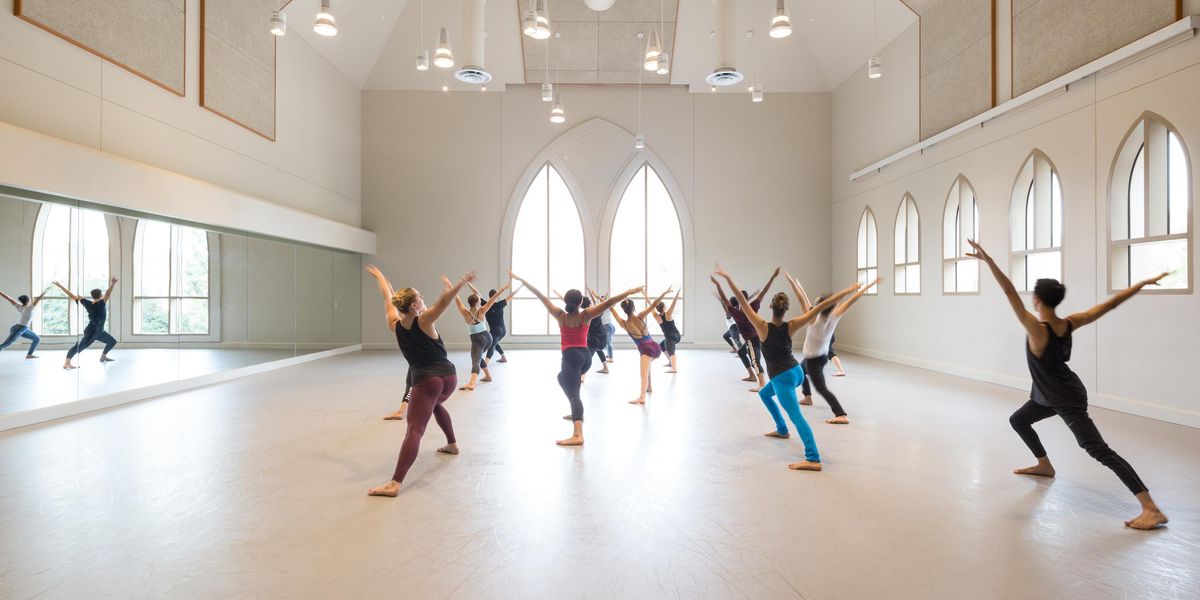Flying Lessons
Training in aerial dance is still relatively new. When Nancy Smith, founder and artistic director of Frequent Flyers Productions and founder of the Aerial Dance Festival in Colorado, wanted to add aerial work to her repertoire, she locked herself in a studio for eight months to experiment. Keith Hennessy, former Contraband founding member and director of the San Francisco-based company Circo Zero, learned aerials in the late ’90s from circus artists while on tour with the French circus company he co-founded. For Joanna Haigood, artistic director of Zaccho Dance Theatre in San Francisco, it was a circus company that inspired her “to start thinking about choreography in a new way—vertically, horizontally, diagonally, laterally.”
Today these artists are among the growing number of aerial dance teachers. Though they agree on many aspects, each artist maintains his or her own unique approach to the aerial dance curriculum.
Smith starts her students on the low-flying, single point trapeze, in homage to the matriarch of aerial dance and inventor of this apparatus, Terry Sendgraff (see TLC, August 2005). “I really do think it’s a great basis,” Smith says. “What you get from the trapeze is learning where your body is in space. You develop core strength, learn how to breathe, learn how to use your upper body, and that translates to every other piece of apparatus.”
Her students begin learning skills such as “Lion in a Tree” (hanging from the trapeze with one arm and one leg draped over the bar) or “Monkey” (a handy transitional skill of locking the arms around one knee so the body hangs from the bar supported by the knee and armpits). They then slowly begin linking movements together. Initially there is no phrase work similar to what you would find in a dance technique class. Instead there is free-form swinging to satiate the students’ craving for momentum.
Together with her dancers, Smith developed an aerial vocabulary. “You learn words, that’s the first step,” says Smith. “Then you can start making sentences and paragraphs and stories.” When students develop a new movement, they get to name it and it’s added to the vocabulary.
It takes a tremendous amount of strength to hang—even briefly—from most aerial apparatus. Though the first class may be humbling, trained dancers can take refuge in structures borrowed from more traditional models, such as a group warm-up or the use of improvisation to generate material.
Haigood takes her students through different movement ideas, such as rolling or balancing, on a variety of apparatus. Boulders suspended from steel cables, large hoops (one more than six feet in diameter!), and different levels of platforms are some of the many means to be airborne in her classes. Haigood’s use of varied apparatus comes from her work on site-specific projects, where there is a need to respond to different environments. “I change the situation as often as possible,” she says. “The students can apply their skills in different ways and deepen their understanding of what they already know.”
Even with exponential growth in the idiom, there are still few places where one can train in aerial dance. Festivals such as Smith’s fill the void, offering two weeks of intensive training with national and international aerial artists.
“I’m trying to give people as much information as possible about all the ways to be in the air,” Smith says. The 2005 faculty included Hennessy and Robert Davidson (whose choreographic labs are based on the Skinner Releasing Technique), as well as more circus-based artists such as former Cirque du Soleil performers Elsie and Serenity Smith and French fabric artist Fred Deb’.
Often students leave the festival with the hopes of building an aerial dance community in their hometown. For this reason, Smith makes certain that festival participants learn about rigging, safety, and injury prevention (a specialty of Elsie and Serenity, who have their own trapeze and circus school, Nimble Arts, in Vermont).
“Many people have a hard time achieving technical ability because they’re not using their bodies efficiently,” Elsie Smith says. The Nimble Arts form of injury prevention, which focuses on keeping the shoulders safe while hanging, and proper posturing in the air, “makes you more successful and promotes less wear and tear on the body.”
For Hennessy, the ideal aerial training combines experimentation and creativity with specialized technical training that only experts in the field can provide. “There are a lot of people who are making aerial work and their technical level is actually very low. They’ve learned six moves on fabric from their friends and then they watched Cirque du Soleil videos to learn a few more moves. And then they’re choreographing and making a website and then teaching. Because the work is so new, there’s a wide range of talent out there,” he cautions. “There’s no replacing learning fabric from someone who’s good at it, or a really clear introduction to trapeze and what the basic moves are.”
Dancers know you can’t get everything you need from one teacher. The same holds true in aerial training. Perhaps the best advice for entering this field is to grip the apparatus tightly, but keep a loose hold on expectations.
Cari Cunningham is the dance critic for
The Daily Camera in Boulder, Colorado. She is currently pursuing her MFA in dance at the University of Colorado, Boulder.




